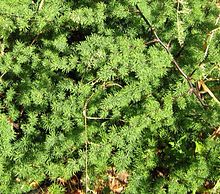Asparagus rubicundus ("red-stemmed asparagus") is a fluffy, thorny shrub of the Asparagus genus, that is endemic to the Cape Provinces of South Africa.[1][2][3]
Description

This species of Asparagus grows as a thorny bush, to a height of 1,5 metres.
Stems are erect, round, smooth, shiny and have a distinctive dark-brown colour.
At each node along a stem, below the branch, there is a single, recurved-spreading (max.6mm) thorn.
The numerous, thread-like leaves are in feathery tufts of about 10. Individual leaves are small (3-7mm), linear-cylindrical, slightly curved, and slightly broader towards their tips.
The flowers (March–June) are white, usually solitary, and have brown stamens. The berries are reddish or black, each with a single seed.[4]
The young shoots of this plant are edible, like those of commercial asparagus.[5]
Related species
This species is part of a group of closely related African Asparagus species, including Asparagus lignosus, Asparagus concinnus and Asparagus microraphis.[6]
Distribution

It occurs throughout the southern and western Cape, as far north as Namibia, and as far east as Uitenhage. It is usually found in coarse sandy, clay or granite-based soil in fynbos or renosterveld vegetation and coastal sand plains.
References
- ^ a b Asparagus rubicundus P.J.Bergius. Plants of the World Online. Retrieved 2 September 2023.
- ^ "Asparagus rubicundus (Family: Asparagaceae)". www.greenplanet.co.za. Archived from the original on 2016-03-04.
- ^ Asparagus rubicundus PlantZAfrica
- ^ "Asparagus rubicundus | PlantZAfrica".
- ^ "Medicinal plants of Fernkloof Nature Reserve". Archived from the original on 2012-07-29. Retrieved 2012-11-27.
- ^ Maria F Norup, Gitte Petersen, Sandie Burrows, Yanis Bouchenak-Khelladi, Jim Leebens-Mack, J Chris Pires, H Peter Linder, Ole Seberg. (2015). Evolution of Asparagus L. (Asparagaceae): Out-of-South-Africa and multiple origins of sexual dimorphism. Molecular Phylogenetics and Evolution 92: 25-44.
Further reading
- Pink, A. (2004). Gardening for the Million. Project Gutenberg Literary Archive Foundation.








